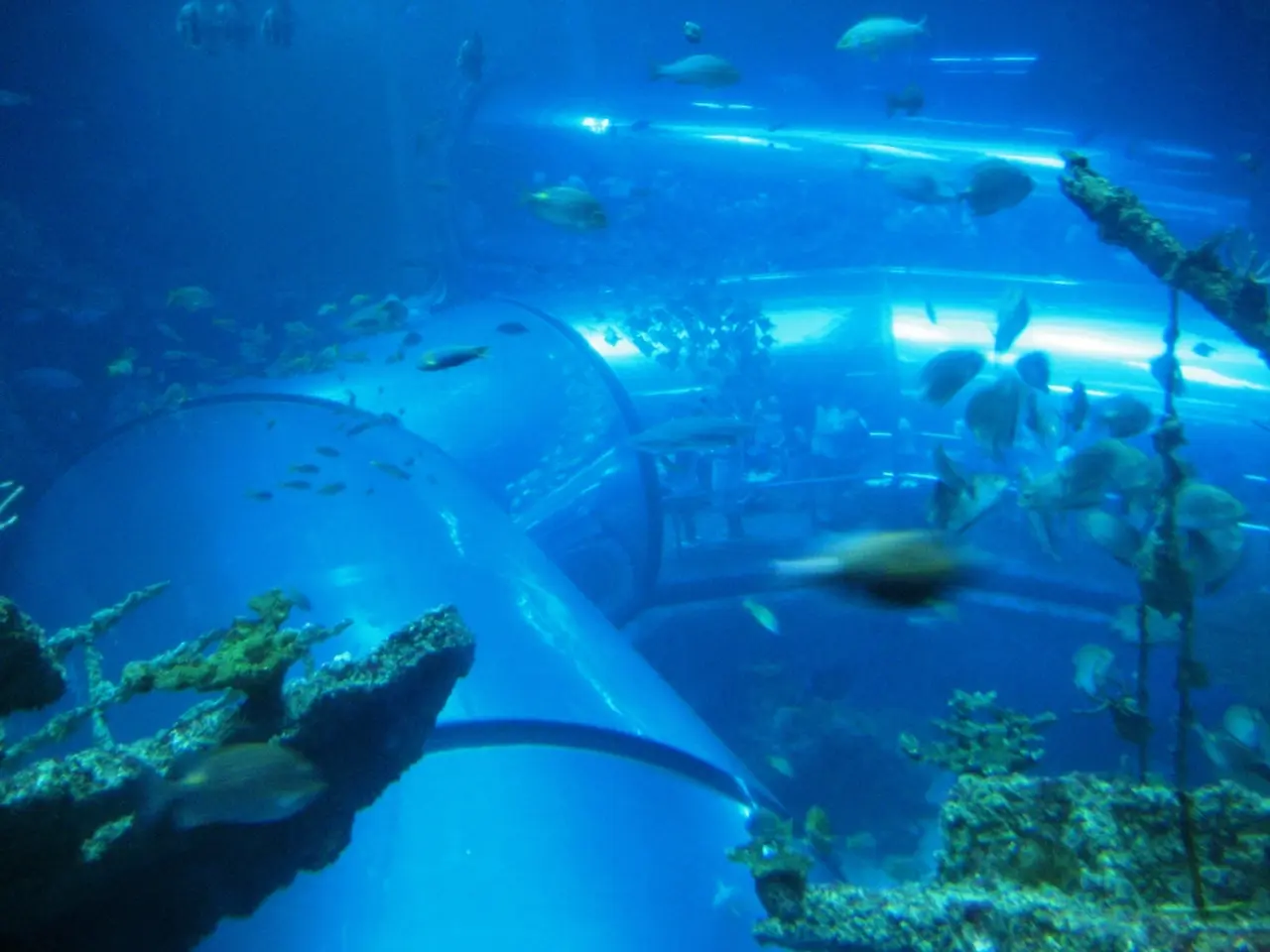Aquiculture industry in Indonesia requires technical support and financial backing to align its current status with the grandeur of the touted "blue economy": according to experts.
Indonesia's blue economy, encompassing seaweed and shrimp farming sectors, holds significant potential, with estimates suggesting it could be worth $1.33-$1.36 trillion and account for 15% of the country's GDP by 2045 [1]. However, the sector faces several challenges in accessing funding, particularly in shrimp farming and seaweed cultivation.
Challenges
Cross-sector coordination is a key issue, as the development of the blue economy relies on collaboration between government, private sector, and civil society [1][3]. Uneven regional performance, with some areas underperforming in blue economy indices, also hinders funding access and resources [1]. Environmental sustainability and maritime security concerns, fundamental to blue economy success, also impact investment risks [3]. Legal and financial infrastructure gaps affect many village cooperatives, impacting their ability to secure funding [2]. Finally, a lack of clear, stable policies can be a barrier to attracting and maintaining investment [2].
Potential Solutions
Addressing these challenges requires a multi-faceted approach. Strengthening inclusive financing schemes, such as the government’s Merah Putih Village/Urban Cooperatives program and People’s Business Credit (KUR) scheme, can help [2]. Cross-sector and international collaboration, facilitated by platforms like Ocean Center Indonesia, can improve access to funding and technical support [3].
Sustainable and science-based development, balancing growth with environmental concerns, can attract responsible investment and donor financing [1]. Capacity building and legal entity support for cooperatives can improve their eligibility for finance and government programs [2]. Monetizing blue carbon and ecosystem services, such as seagrass and peatland blue carbon profiling, could provide emerging funding mechanisms [4].
Banks are more likely to finance companies further down the shrimp supply chain, such as processing firms, due to lower risk [5]. Indonesia's much-delayed carbon trading scheme, expected to come online later this year, could offer additional funding opportunities [5]. The Indonesian government has taken steps towards this, signing a carbon market alliance with Japan and making a mutual recognition agreement with Gold Standard in May [5].
Indonesia's shrimp trade, the country's largest seafood sector, has remained stagnant, despite a government target to boost shrimp export earnings by 250% by 2024 [5]. The shrimp farming sector, like seaweed cultivation, faces challenges due to overproduction estimates, which have been overstated by almost seven times compared to industry estimates [6]. The case of agritech startup EFishery, which was alleged to have inflated revenue figures, has further undermined confidence in the market [6].
To overcome these challenges, it is crucial to focus on policy alignment, environmental stewardship, and regional capacity building. By fostering public-private partnerships, improving legal status for cooperatives, and strengthening quality verification systems, Indonesia can attract investment and ensure the sustainable growth of its blue economy [1][2][3][4].
[1] The Jakarta Post, "Blue Economy to account for 15% of Indonesia's GDP by 2045", 11 November 2020. [2] The Jakarta Post, "Government launches Merah Putih Village/Urban Cooperatives program", 12 August 2020. [3] The Jakarta Post, "Indonesia's Ocean Center Indonesia aims to promote innovation, capacity building, and adaptation of international best practices", 26 October 2020. [4] The Jakarta Post, "Regional initiatives on blue carbon financing could support seaweed sectors", 15 February 2021. [5] The Jakarta Post, "Indonesia signs carbon market alliance with Japan", 1 October 2021. [6] The Jakarta Post, "Indonesia's official seaweed production volume overstated by seven times", 24 February 2021.
- The development of Indonesia's blue economy hinges on cross-sector coordination between government, private sector, and civil society.
- Uneven regional performance in the blue economy indices is a hindrance to funding access and resources.
- Environmental sustainability and maritime security concerns impact investment risks associated with the blue economy.
- Legal and financial infrastructure gaps affect many village cooperatives, limiting their ability to secure funding.
- A lack of clear, stable policies can become a barrier to attracting and maintaining investment in the blue economy.
- Strengthening inclusive financing schemes like the government’s Merah Putih Village/Urban Cooperatives program and People’s Business Credit (KUR) scheme can help address these challenges.
- Cross-sector and international collaboration, facilitated by platforms like Ocean Center Indonesia, can improve access to funding and technical support.
- Sustainable and science-based development, balancing growth with environmental concerns, can attract responsible investment and donor financing.
- Capacity building and legal entity support for cooperatives can improve their eligibility for finance and government programs.
- Monetizing blue carbon and ecosystem services, such as seagrass and peatland blue carbon profiling, could provide emerging funding mechanisms.
- Banks are more likely to finance companies further down the shrimp supply chain due to lower risk.
- Indonesia's much-delayed carbon trading scheme, expected to come online later this year, could offer additional funding opportunities.
- It is crucial to focus on policy alignment, environmental stewardship, and regional capacity building to overcome challenges and attract investment in the blue economy.
- By fostering public-private partnerships, improving legal status for cooperatives, and strengthening quality verification systems, Indonesia can ensure the sustainable growth of its blue economy.




